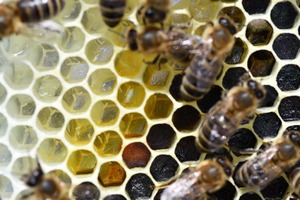Egg Laying

Before the queen bee lays an egg, she examines the empty cell by putting her head into it. After she has taken her head out of the cell, she walks forward one or two steps until the tip of the rear of her body is over the cell opening. She then arches her body and puts most of it into the cell, as you can see in the picture. After a few seconds in this position she lays an egg and walks forward to examine another cell and lay another egg. After she has laid several eggs, she stops for a few moments and eats royal jelly offered by worker nurse bees surrounding her. While she is resting and eating, more eggs are completing their development inside her body. Day after day, the queen continues to lay eggs at a rapid pace. By the end of the season she may have laid 200,000 eggs. Each day a queen may produce as many as 2,000 eggs, but an average of 1,200 eggs a day is more typical. This number of eggs is equal to one or two times her body weight! The queen must lay this number just to keep a colony supplied with a large number of workers. An example shows how this works. If the queen bee laid 1,000 eggs every day and the worker bees live about six weeks each, then the number of worker bees in the colony would remain steady at about 42,000, which is the usual number in a medium sized colony.
Most brood cells (cells where eggs are laid) are located at the center of the nest. Within this area, bees keep the temperature about 94Ā°F. Toward the outer edge of the nest or hive, the temperature changes more as the outside temperature changes. Bees tend to store honey near the upper edges of the nest while pollen is stored between the honey cells and the central brood area. The queen starts laying eggs near the center Of the nest. Gradually the brood area is expanded outwards in all directions. Not all cells are filled with developing eggs at any given time. This is true because it takes 21 days for a bee to develop from the egg stage to the adult stage. As a result, cells become empty each day, as adult workers come out of cells that received an egg 21 days before.
It is difficult to understand how the queen bee, in the darkness of the hive, surrounded by thousands of workers that seem to get in halfway, can find the thousands of cells that have been prepared for egg laying. If she just wandered around examining all the cells in the comb, she would lose time and spend energy without laying eggs. Scientists think that queens must have an efficient way of finding the empty cells. Perhaps the queen is attracted to a special odor that the workers put on the walls as they clean the cells.
The queen may continue laying eggs all year long in tropical areas where there are flowers at all times. In areas where there is a flowerless winter season the queen begins to lay fewer eggs each day as fall approaches. By late fall there may be no brood developing in the hive. During the winter the bees that are left cluster together in a ball and eat stored honey to stay alive. The queen begins laying eggs again towards the end of winter. No one knows what causes the queen to begin egg laying again. There may still be snow on the ground when this happens. In spite of the cold the brood comb is kept at the correct temperature for brood-rearing. The bees do this by clustering tightly together and using the energy in honey to produce heat. By the time the spring flowers are out there are plenty of new bees to take care of the nest and collect food.
The Bees section was created with special thanks to Louis Juers (Arizona State Parks & Trails) for providing information used in this section. Additional information and digital materials were obtained from some of the following organizations. We would like to thank them for all their dedication and hard work within their profession.
|









